A New Energy Efficient Multitier Deterministic Energy-Efficient Clustering Routing Protocol for Wireless Sensor Networks
Abstract
1. Introduction
2. Classification of Routing Protocols
2.1. Low Energy Adaptive Clustering Hierarchy (LEACH) Protocol
2.2. Power-Efficient Gathering in Sensor Information Systems (PEGASIS)
2.2.1. Formation of the Chain among the Sensor Nodes
2.2.2. Data Gathering
2.3. Deterministic Energy-Efficient Clustering (DEC) Protocol
2.3.1. DEC Network Model and Energy Dissipation
2.3.2. Energy Heterogeneity
3. Proposed Multi-Tier Protocol
- Election of Cluster Heads is locally decided as per the residual energy of all the cluster members.
- Each round is independent in itself.
- The protocol gives an assurance to utilize all the available nodes.
- MDEC ensures a fixed number of desired cluster-heads.
- MDEC minimizes the overhead computing costs associated with the CH quest.
- It maintains stability and avoids failure during packet transmission, due to the regular check of REs.
4. Simulation and Analysis
4.1. Simulation Setup
4.2. Proposed Algorithm for NR-MDEC Protocol
- Step-1: Creation of Virtual Environment for WSN Network.
- Step-2: Getting values of various parameters from the field.
- Step-3: Divide all nodes in 4-Categories—Normal, Advanced, Intermediate, Advanced-Intermediate.
- Step-4: Sorting of nodes as per their Residual Energies.
- Step-5: Selection of 10% nodes having the highest energy as Cluster Heads.
- Step-6: Apply energy minimization on nodes and also calculate their REs.
- Step-7: If CH-RE is greater, keep CH and repeat energy minimization algorithm else go to Step-4.
- Step-8: Stop after delivering all the packets or exhaustion of nodes energy.
5. Results and Discussion
6. Conclusions
Author Contributions
Funding
Conflicts of Interest
Abbreviations
| DEC | Deterministic Energy-efficient Clustering |
| LEACH | Low Energy Adaptive Clustering Hierarchy |
| PEGASIS | Power-Efficient Gathering in Sensor Information Systems |
| SEP | Stable Election Protocol |
| CH | Cluster Head |
| CSMA | Carrier-sense multiple access |
| MAC | Media Access Control |
| ADV | Advertisement |
| NR-MDEC | Non-Residua Modified-DEC |
| FND | First Node Dead |
| LND | Last Node Dead |
References
- Sankarasubramaniam, Y.; Cayirci, E.; Akyildiz, I.F. Wireless sensor networks: A survey. Comput. Netw. 2001, 38, 393–422. [Google Scholar] [CrossRef]
- Akyildiz, I.F.; Weilian, S.; Sankarasubramaniam, Y.; Cayirci, E. A survey on sensor networks. IEEE Commun. Mag. 2002, 40, 102–114. [Google Scholar] [CrossRef]
- Aderohunmu, F.A.; Deng, J.D.; Purvis, M.K. Enhancing clustering in wireless sensor networks with energy heterogeneity. Int. J. Bus. Data Commun. Netw. 2011, 7, 18–31. [Google Scholar] [CrossRef]
- Estrin, D.; Govindan, R.; Heidemann, J.; Kumar, S. Next, century challenges: Scalable coordination in sensor networks. In Proceedings of the 5th Annual ACM/IEEE International Conference on Mobile Computing and Networking (MobiCom′99), Seattle, WA, USA, 15–20 August 1999; ACM: New York, NY, USA, 1999; pp. 263–270. [Google Scholar] [CrossRef]
- Sharma, T.; Kumar, B.; Tomar, G.S. Performance Comparison of LEACH, SEP and DEEC Protocols in Wireless Sensor Network. UACEE Int. J. Adv. Comput. Netw. Its Secur. 2012, 2, 10–15. [Google Scholar]
- Heinzelman, W.R.; Chandrakasan, A.; Balakrishnan, H. Energy-Efficient Communication Protocol for Wireless Microsensor Networks. In Proceedings of the 33rd Hawaii International Conference on System Sciences (HICSS′00), Maui, HI, USA, 7 January 2000; IEEE Computer Society: Washington, DC, USA, 2000; Volume 8, pp. 1–10. [Google Scholar]
- Smaragdakis, G.; Matta, I.; Bestavros, A. SEP: A Stable Election Protocol for clustered heterogeneous wireless sensor networks. In Proceedings of the Second International Workshop on Sensor and Actor Network Protocols and Applications (SANPA 2004), Boston, MA, USA, August 2004; pp. 251–261. [Google Scholar]
- Vandana, K.A.; Mohan, C. Energy Efficient Routing Protocols in Wireless Sensor Networks: A Survey. Int. J. Eng. Res. Technol. 2015, 4, 1–4. [Google Scholar] [CrossRef]
- Lee, J.Y.; Jung, K.; Jung, H.; Lee, D. Improving the energy efficiency of a cluster head election for wireless sensor networks. Int. J. Distrib. Sens. Netw. 2014, 10, 305037. [Google Scholar] [CrossRef]
- Wu, F.; Chen, T.; Zhong, S.; Li, L.E.; Yang, Y.R. Incentive-compatible opportunistic routing for wireless networks. In Proceedings of the 14th ACM international conference on Mobile computing and networking (MobiCom′08), San Francisco, CA, USA, 14–19 September 2008; ACM: New York, NY, USA, 2008; pp. 303–314. [Google Scholar] [CrossRef]
- Lindsey, S.; Raghavendra, C.S. PEGASIS: Power-Efficient Gathering in Sensor Information Systems. In Proceedings of the IEEE ICC, Big Sky, MT, USA, 9–16 March 2002. [Google Scholar]
- Chaudhary, R.; Vatta, S. Performance Optimization of WSN Using Deterministic Energy Efficient Clustering Protocol: A Review. IOSR J. Eng. (IOSRJEN) 2014, 4, 23–30. [Google Scholar] [CrossRef]
- Brahim, E.; Rachid, S.; Zamora, A.P.; Aboutajdine, D. Stochastic and Balanced Distributed Energy-Efficient Clustering (SBDEEC) for heterogeneous wireless sensor networks. INFOCOMP J. Comput. Sci. 2009, 8, 11–20. [Google Scholar]
- Heinzelman, W.B.; Chandrakasan, A.P.; Balakrishnan, H. An application-specific protocol architecture for wireless microsensor networks. IEEE Trans. Wirel. Commun. 2002, 1, 660–670. [Google Scholar] [CrossRef]
- Qing, L.; Zhu, Q.; Wang, M. Design of a distributed energy-efficient clustering algorithm for heterogeneous wireless sensor networks. ELSEVIER Comput. Commun. 2006, 29, 2230–2237. [Google Scholar] [CrossRef]
- Aderohunmu, F.A.; Deng, J.D.; Purvis, M.K. Enhancing clustering in wireless sensor networks with energy heterogeneity. In Information Science Discussion Papers; Series No. 2009/07; University of Otago: Dunedin, New Zealand, 2009. [Google Scholar]
- Elbhiri, B.; Rachid, S.; El Fkihi, S.; Aboutajdine, D. Developed Distributed Energy-Efficient Clustering (DDEEC) for heterogeneous wireless sensor networks. In Proceedings of the 2010 5th International Symposium on I/V Communications and Mobile Networks, ISIVC, Rabat, Morocco, 30 September–2 October 2010; pp. 1–4. [Google Scholar]
- Sheikhpour, R.; Jabbehdari, S.; Khadem-zadeh, A. Comparison of Energy Efficient Clustering Protocols in Heterogeneous Wireless Sensor Networks. Sci. Addit. Technol. 2011, 36, 27–40. [Google Scholar]
- Yu, M.; Leung, K.K.; Malvankar, A. A dynamic clustering and energy efficient routing technique for sensor networks. IEEE Trans. Wirel. Commun. 2007, 6, 3069–3079. [Google Scholar] [CrossRef]
- Al-Karaki, J.N.; Kamal, A.E. Wireless Sensor Networks Routing Techniques in Wireless Sensor Networks: A Survey. IEEE Wirel. Commun. 2004, 11, 6–28. [Google Scholar] [CrossRef]
- Gobriel, S. Energy-Efficient Design of Adhoc and Sensor Networks. Ph.D. Thesis, University of Pittsburgh, Pittsburgh, PA, USA, 2008. [Google Scholar]
- Latif, K.; Ahmad, A.; Javaid, N.; Khan, Z.A.; Alrajeh, N. Divide-and-rule scheme for energy efficient routing in wireless sensor networks. Procedia Comput. Sci. 2013, 19, 340–347. [Google Scholar] [CrossRef]


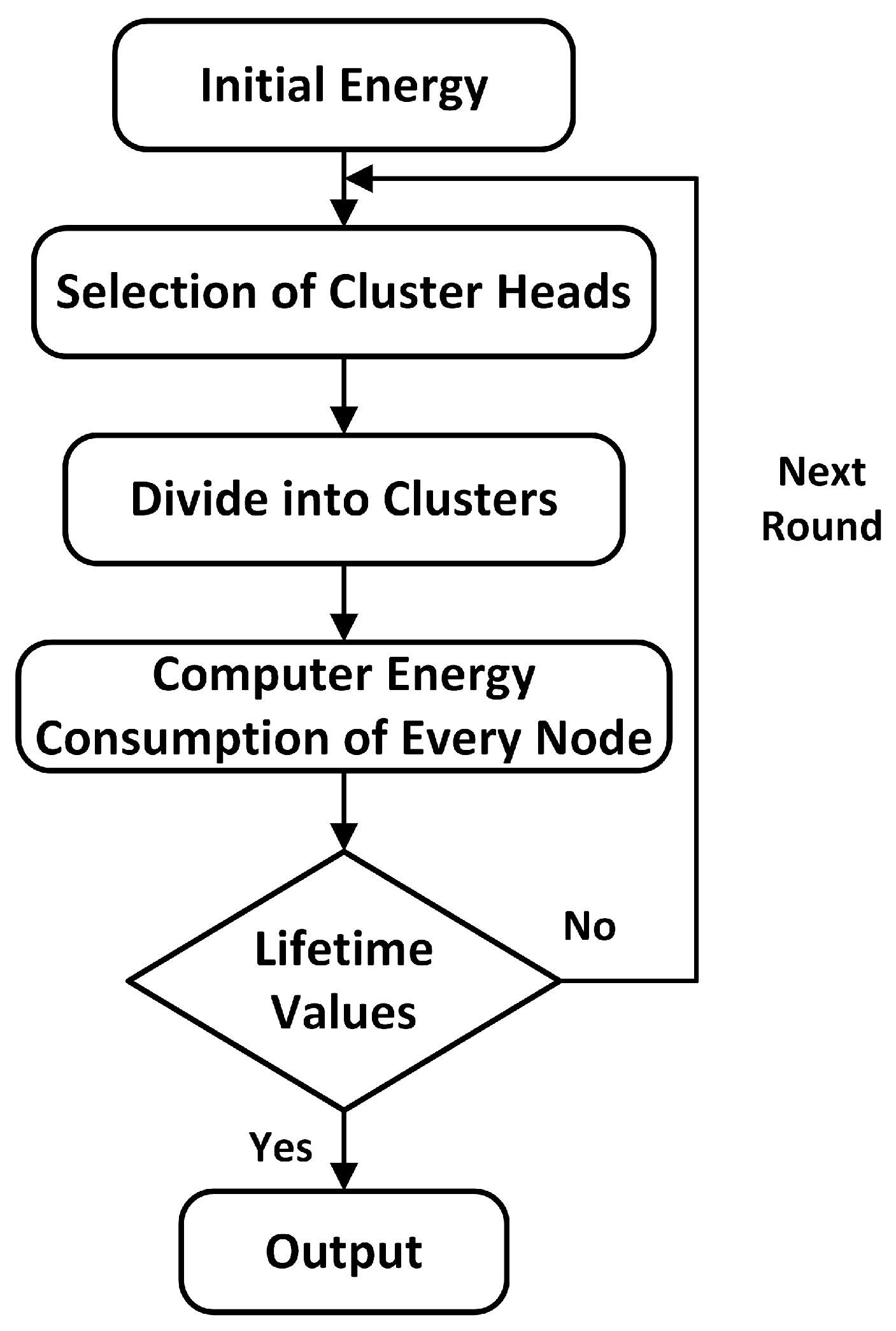
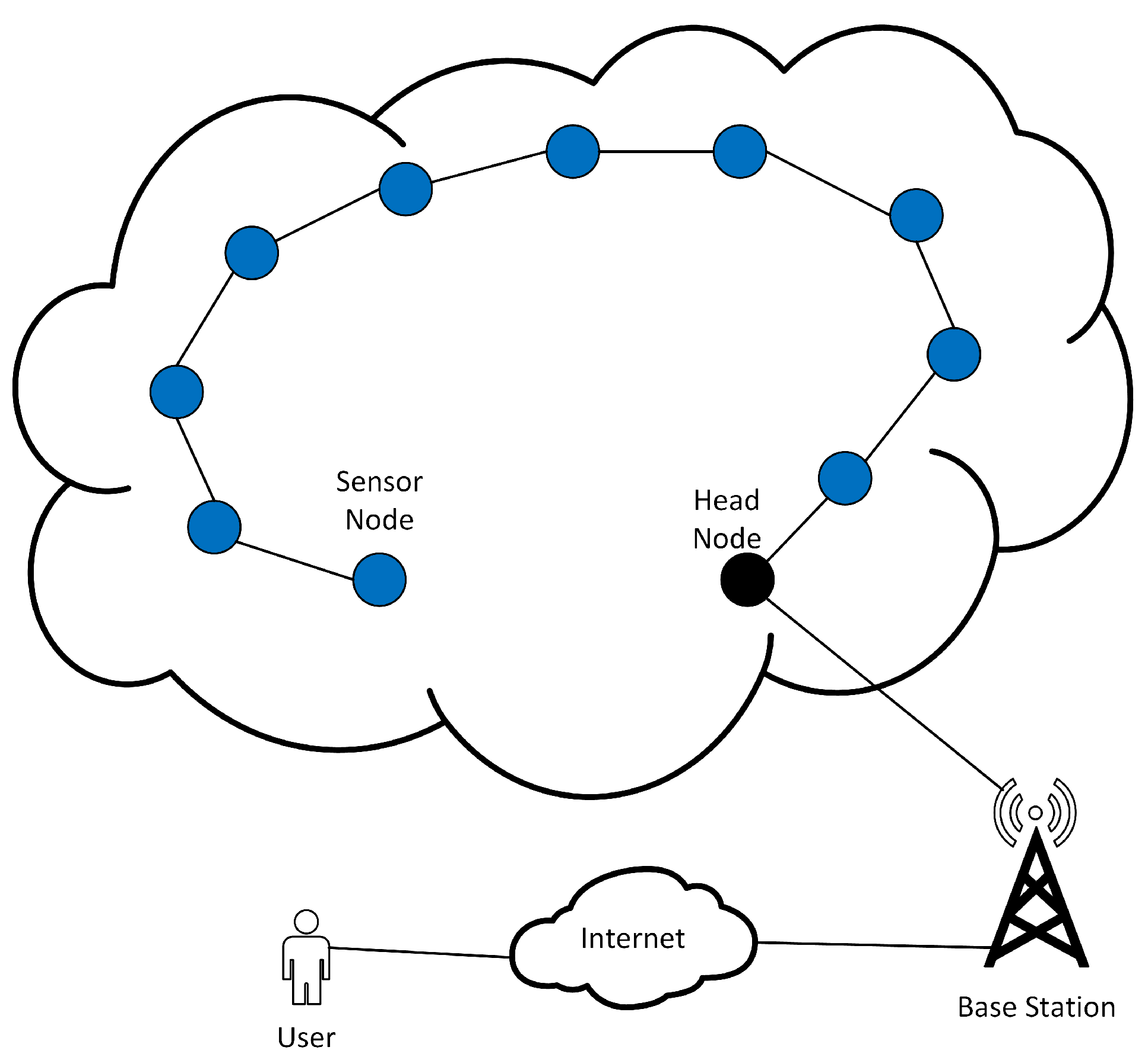
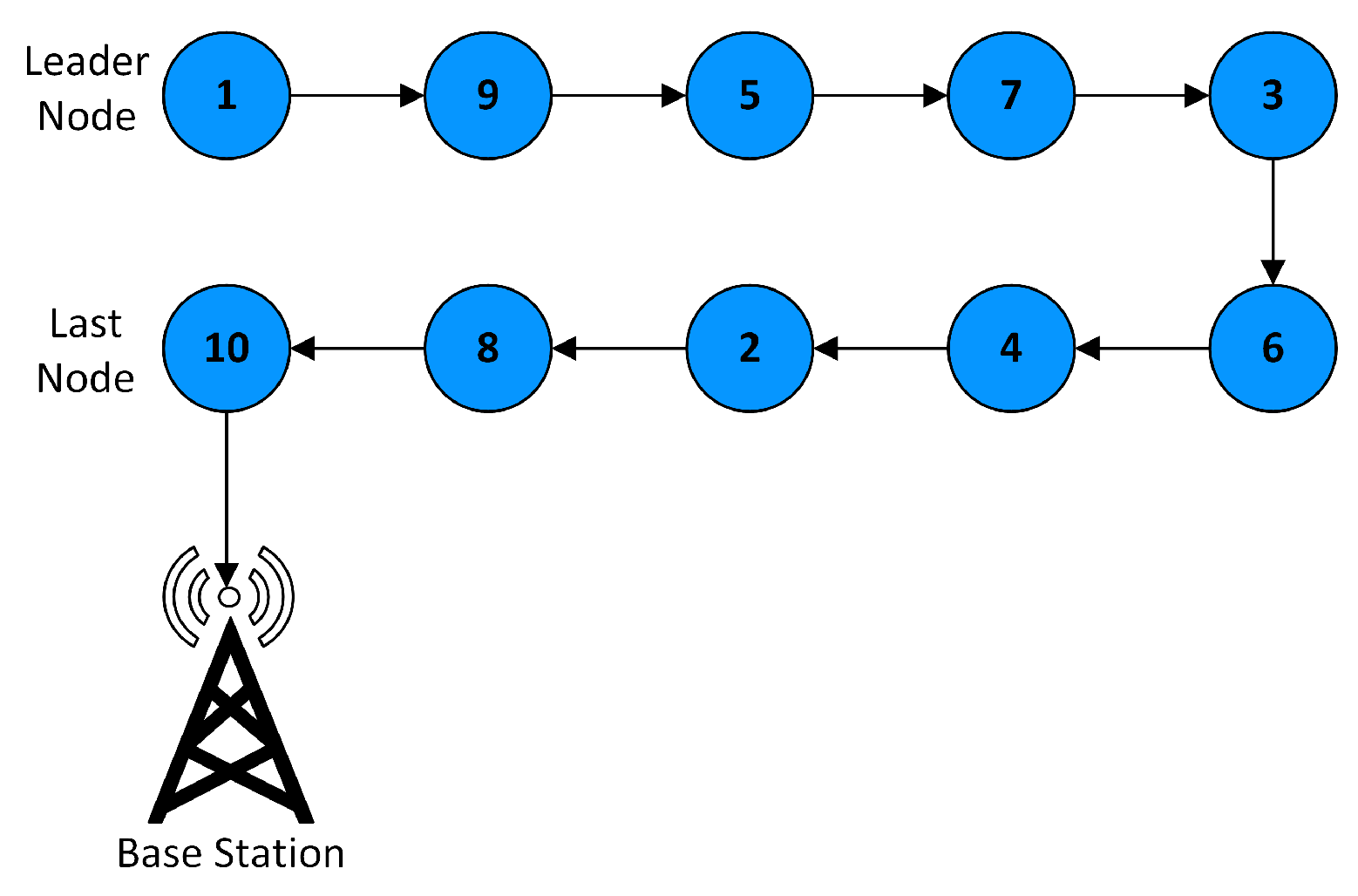



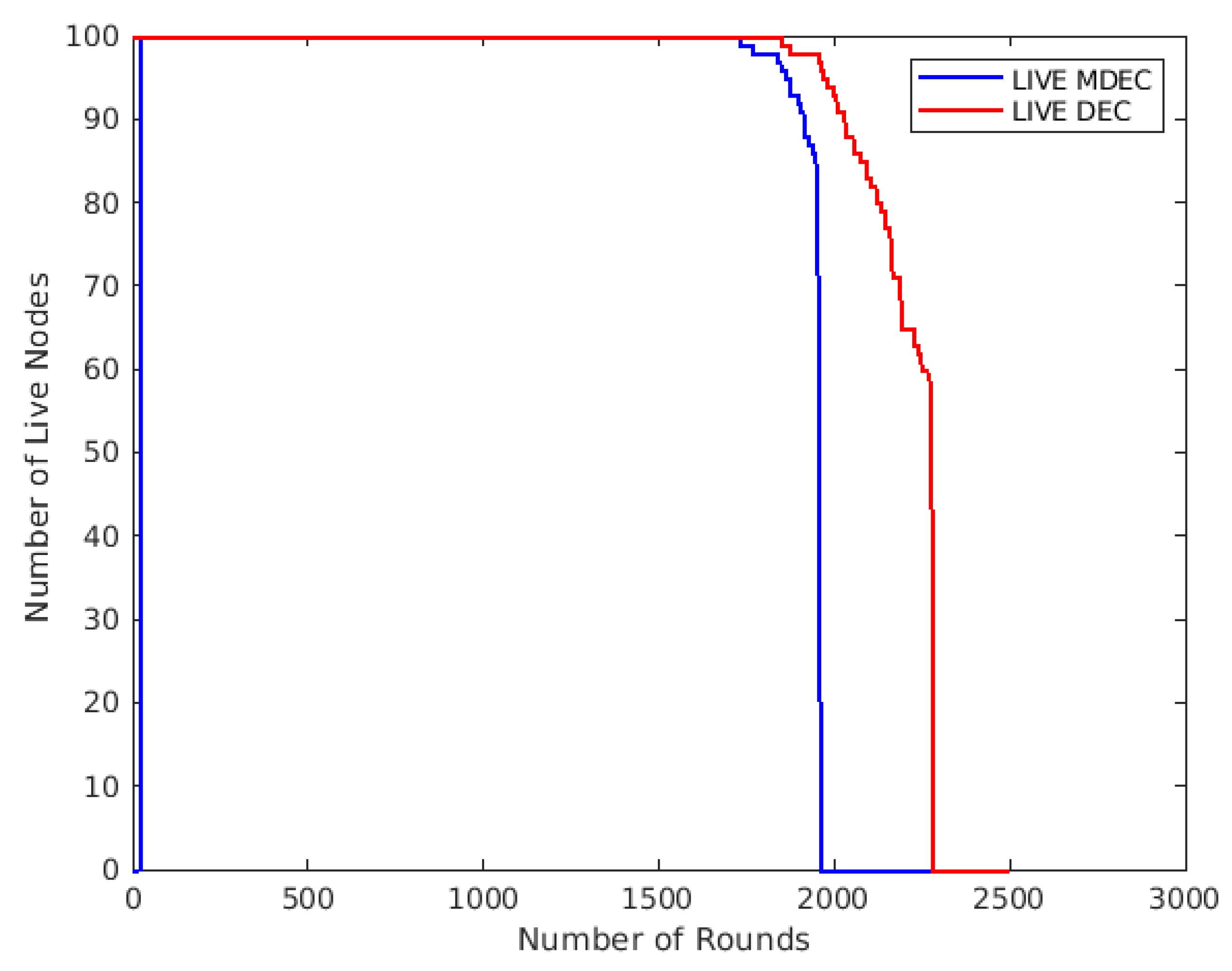
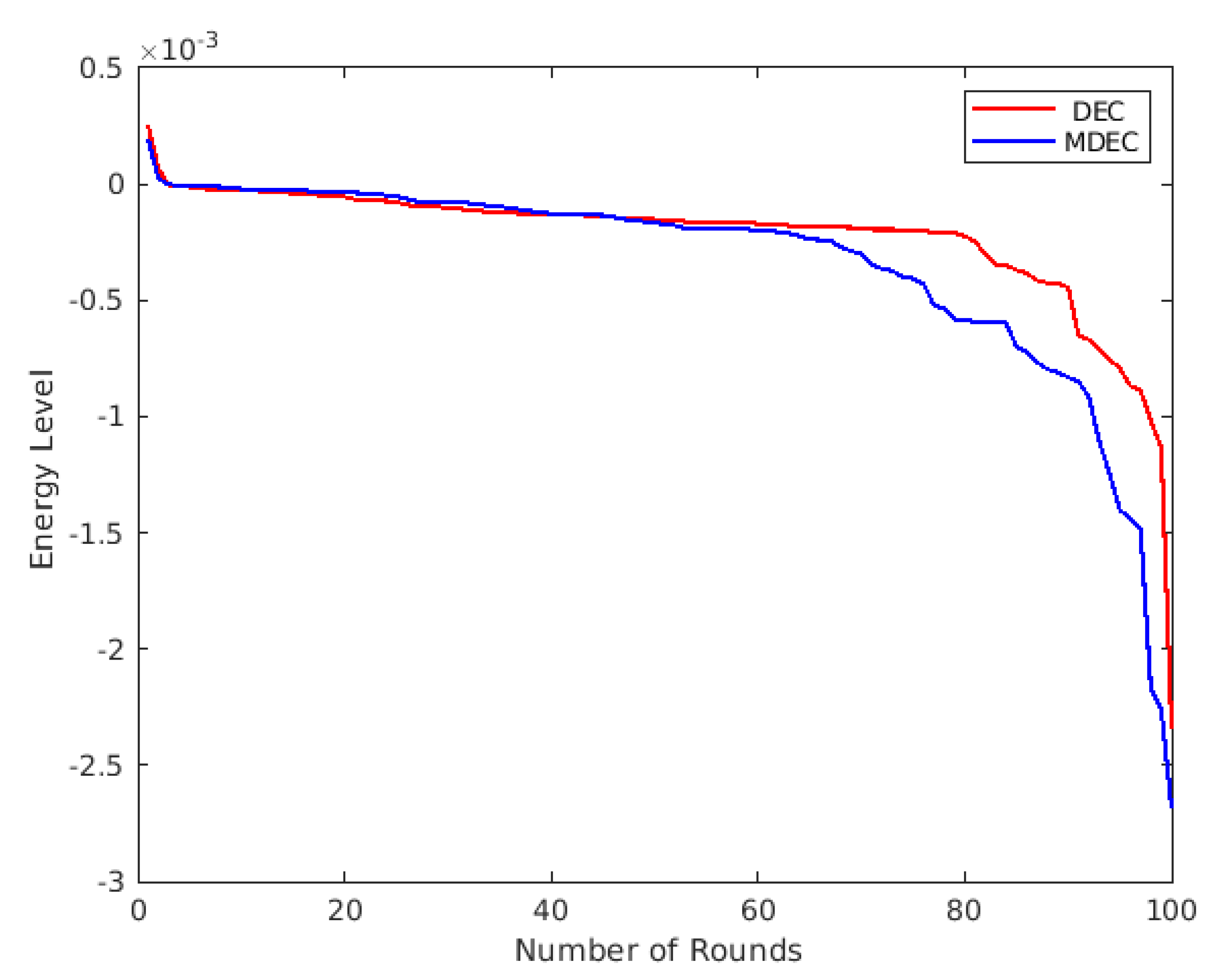
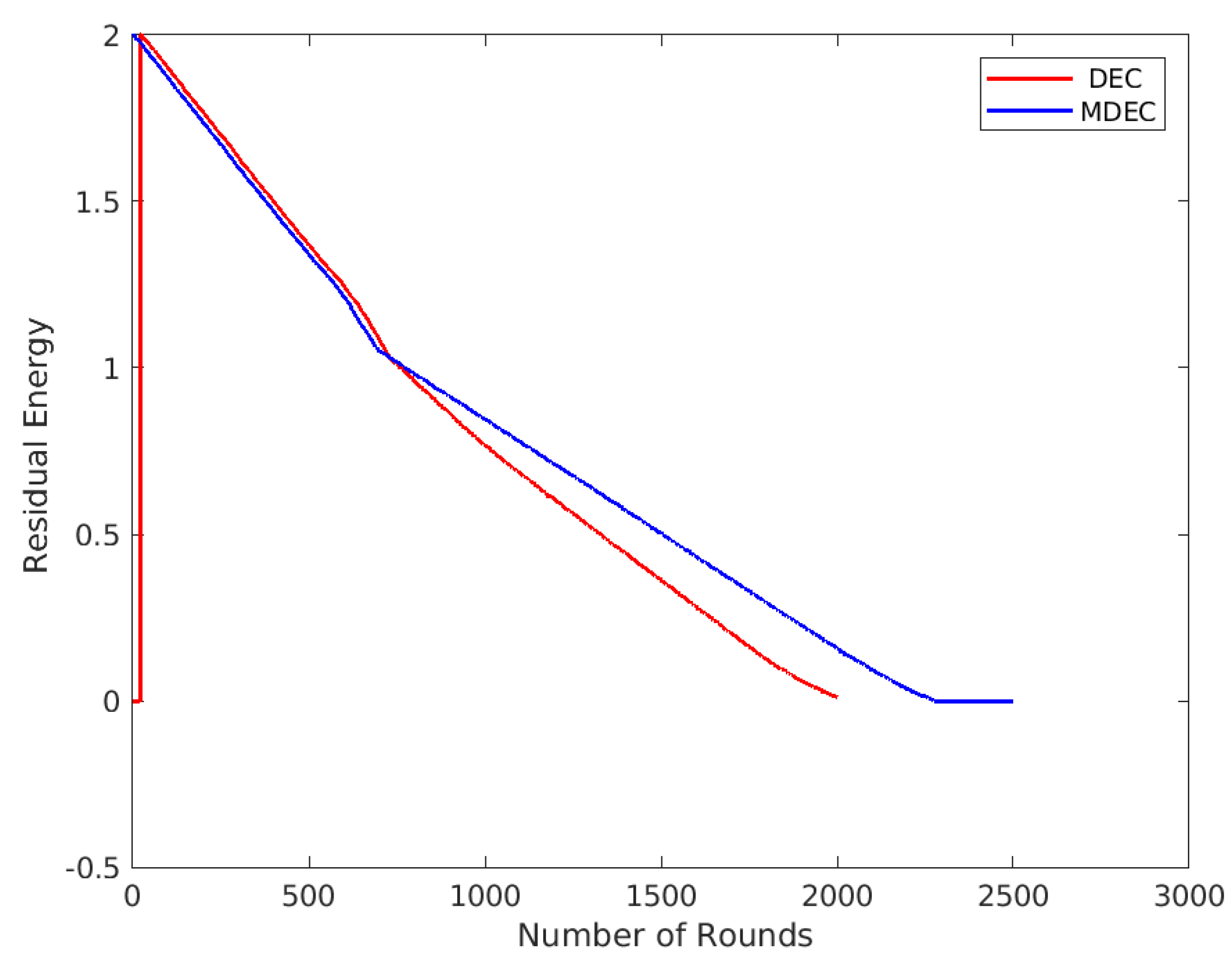
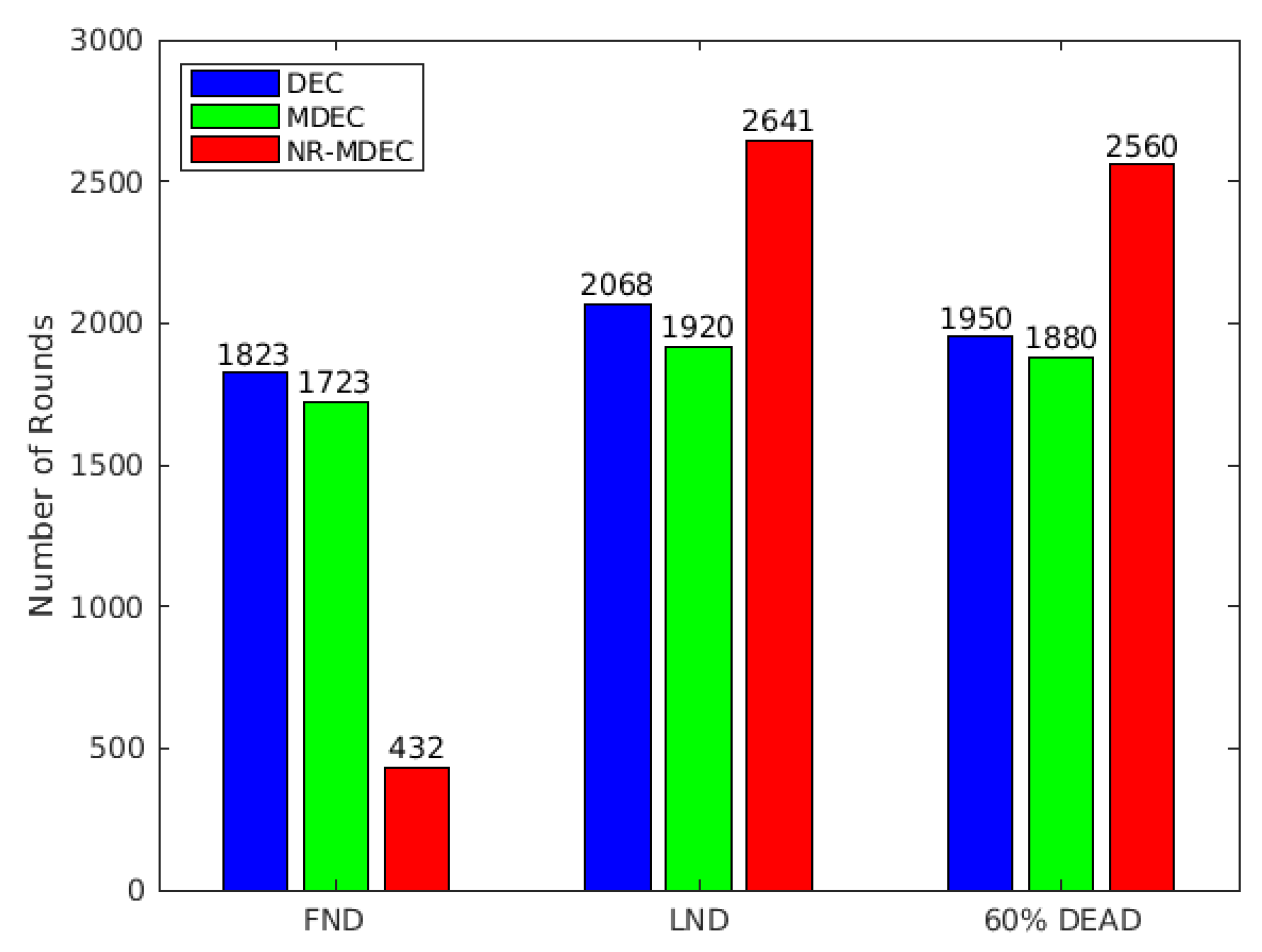
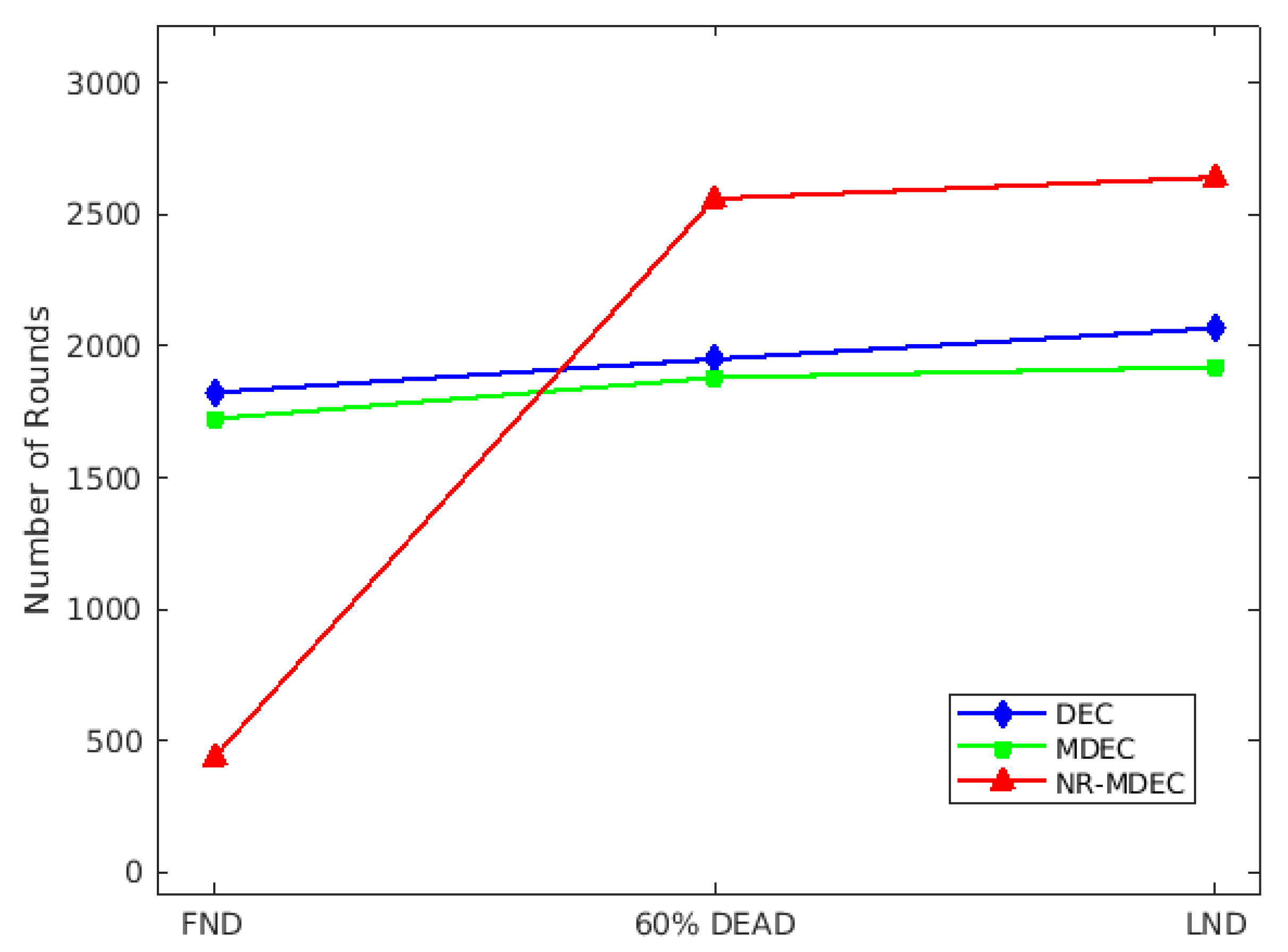
| Parameter | Description | Value |
|---|---|---|
| % of advanced nodes | 0.2 | |
| % of intermediate nodes | 0.2 | |
| % of advanced-intermediate nodes | 0.1 | |
| Initial energy | 0.5 J | |
| Optimal Election Probability of a node | 0.1 | |
| % increment in the energy of the advance nodes concerning normal nodes | 3 | |
| % increment in the energy of the intermediate nodes concerning normal nodes | 1 | |
| % increment in the energy of the advance–intermediate nodes concerning normal nodes | 1.5 |
| Parameter | Symbolic Significance | Value |
|---|---|---|
| Sink Node Coordinates | ||
| No. of Nodes | Nodes or n | 500 |
| Initial Energy | 0.5 J | |
| Transmission Power | J | |
| Received Energy | J | |
| Data Aggregation Energy | J | |
| Max. Rounds | rmax | 3000 |
| Packet Size | Packet | 4000 bits |
| Description | Symbol | Value |
|---|---|---|
| Energy used by the amplifier for short-range transmission | 10 pJ/bit/m | |
| Energy consumed for long-distance transmission by the amplifier | 0.0013 pJ/bit/m | |
| The energy required to send or receive the signal in the electronics loop | 50 nJ/bit | |
| Energy used for the formation of beams | 5 nJ/bit |
© 2020 by the authors. Licensee MDPI, Basel, Switzerland. This article is an open access article distributed under the terms and conditions of the Creative Commons Attribution (CC BY) license (http://creativecommons.org/licenses/by/4.0/).
Share and Cite
Koyuncu, H.; Tomar, G.S.; Sharma, D. A New Energy Efficient Multitier Deterministic Energy-Efficient Clustering Routing Protocol for Wireless Sensor Networks. Symmetry 2020, 12, 837. https://doi.org/10.3390/sym12050837
Koyuncu H, Tomar GS, Sharma D. A New Energy Efficient Multitier Deterministic Energy-Efficient Clustering Routing Protocol for Wireless Sensor Networks. Symmetry. 2020; 12(5):837. https://doi.org/10.3390/sym12050837
Chicago/Turabian StyleKoyuncu, Hakan, Geetam S. Tomar, and Dinesh Sharma. 2020. "A New Energy Efficient Multitier Deterministic Energy-Efficient Clustering Routing Protocol for Wireless Sensor Networks" Symmetry 12, no. 5: 837. https://doi.org/10.3390/sym12050837
APA StyleKoyuncu, H., Tomar, G. S., & Sharma, D. (2020). A New Energy Efficient Multitier Deterministic Energy-Efficient Clustering Routing Protocol for Wireless Sensor Networks. Symmetry, 12(5), 837. https://doi.org/10.3390/sym12050837





